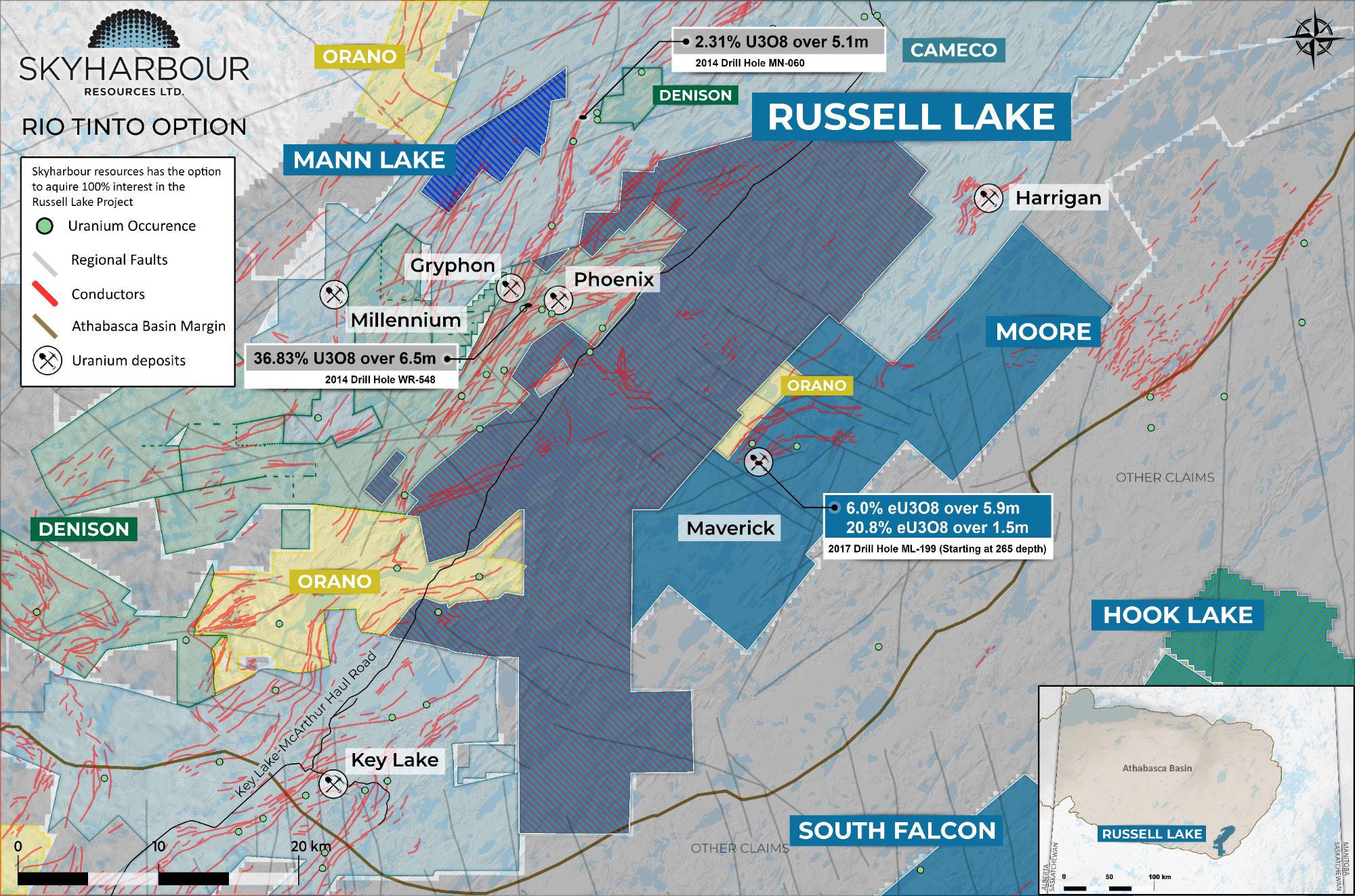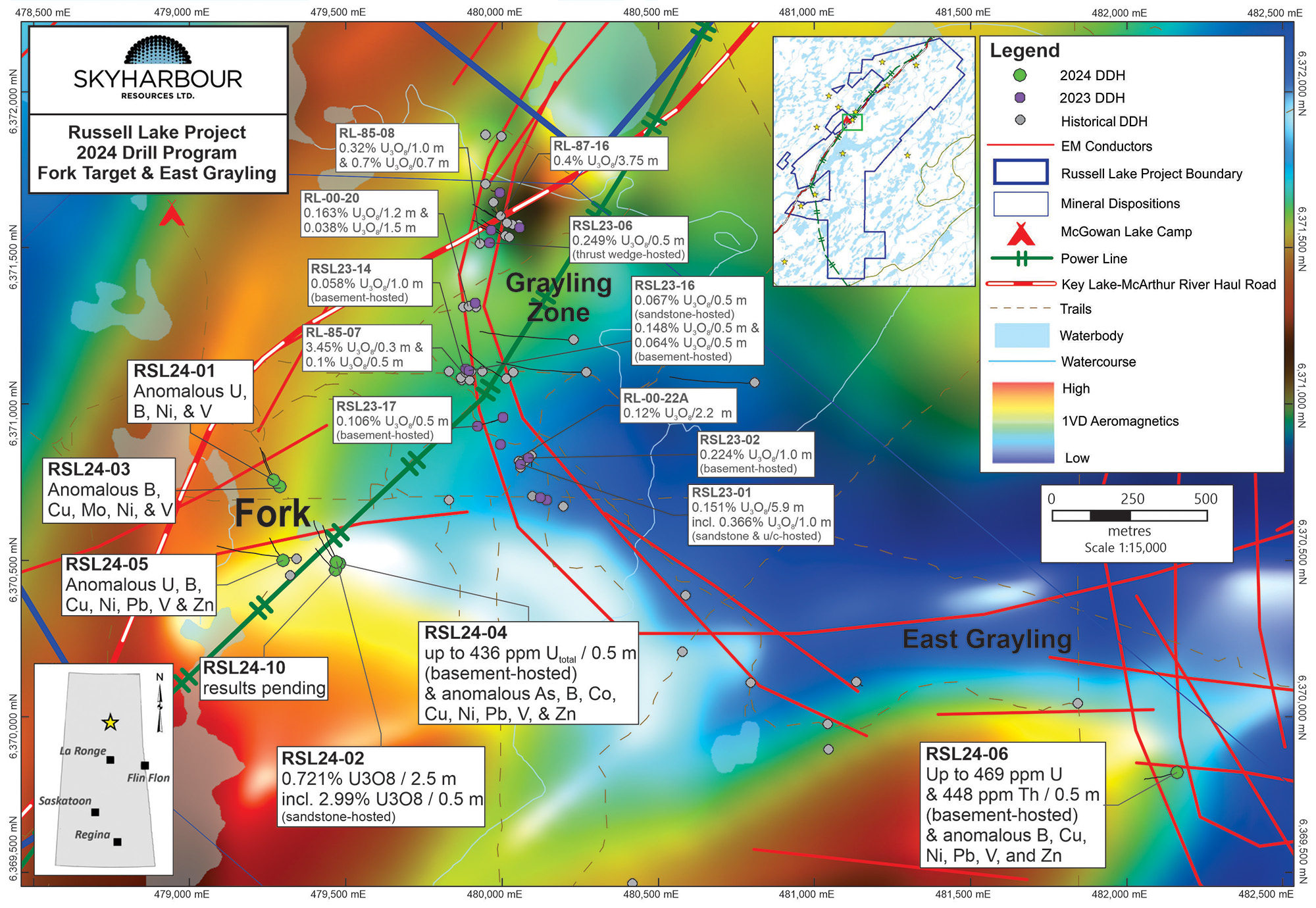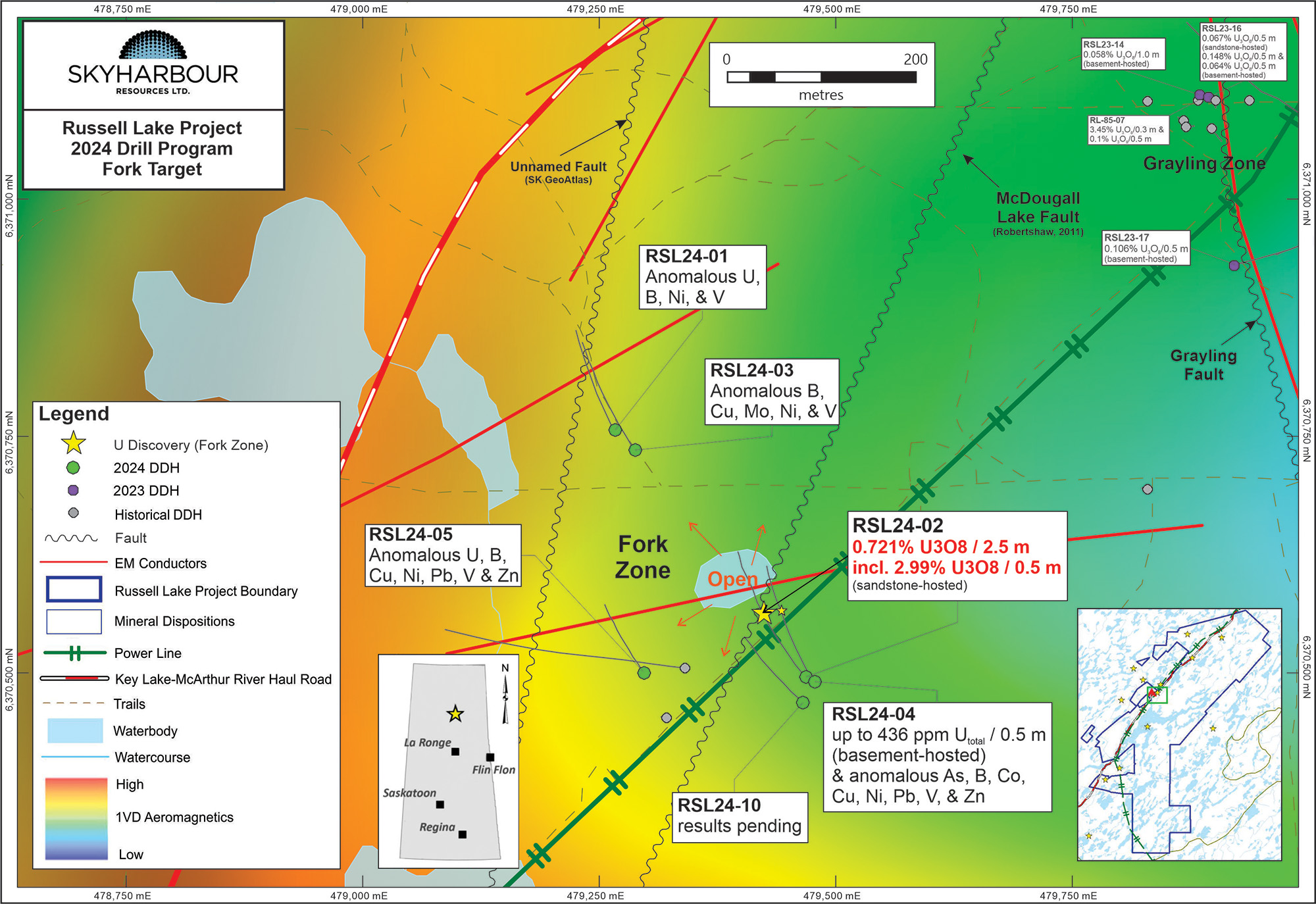Russell Lake - Core Project
Russell Lake Property Highlights:
- Option to acquire an initial 51% and up to 100% of Rio Tinto’s 73,294 ha Russell Lake Uranium Property strategically located in the central core of the Eastern Athabasca Basin of northern Saskatchewan
- Both Highway 914 servicing McArthur River and a high-voltage power line connected to the provincial power grid run through the Property’s western claims. There is a fully permitted exploration camp on the Project suitable for over forty people located on the highway and within 5 kilometres of Denison’s Phoenix deposit
- Skyharbour, as operator, can earn an initial 51% interest in the Property by paying CAD $508,200 in cash, issuing 3,584,014 common shares to RTEC, and funding CAD $5,717,250 in exploration on the Project, inclusive of a 10% management fee to Skyharbour, over a period of 3 years
- Skyharbour has a second option to earn an additional 19% interest for a total of 70%, and a further possible option to obtain the remaining 30% interest in the Project for an undivided 100% ownership interest
- The Property has been the subject of significant historical exploration efforts including over 95,000 metres of drilling in over 220 drill holes. This provides the Company with an excellent dataset to direct subsequent exploration on high-priority areas with the potential for near-term discovery of high-grade uranium mineralization
- Previous exploration work has identified numerous highly prospective target areas, some of which host high-grade uranium mineralization in historical drill holes. Furthermore, there are over 35 kilometres of untested conductors on the Property in magnetic lows, which are indicative of pelitic basement rocks conducive to uranium deposition in the Athabasca Basin
- The Property has a permitted and functional exploration camp suitable for over forty people, and conveniently located near Highway 914 and within 5 km kilometres of Denison’s Phoenix deposit. The Property’s claims are in good standing for 2-22 years from banked assessment credits
- This transaction adds another drill-ready, advanced-stage uranium exploration asset to Skyharbour’s project portfolio and offers significant operational and exploration synergies with the adjacent Moore uranium project
- Skyharbour completed an inaugural drilling campaign which consisted 9,595m in nineteen holes over three phases back in 2023
- A total of 5,152 metres of drilling in ten holes was drilled in two phases during the winter of 2024; planning to complete additional 5,000 metres of drilling this summer which is fully funded
- High-grade, sandstone-hosted mineralization up to 2.99% U3O8 was intersected over 0.5 metres in hole RSL24-02 at the new Fork Zone, within an interval of 0.721% U3O8 over 2.5 metres from 338.1 to 340.6 metres downhole just above the unconformity.
Russell Lake Uranium Project:
The Russell Lake Project is a large, advanced-stage uranium exploration property totalling 73,294 hectares strategically located between Cameco’s Key Lake and McArthur River Projects and adjoining Denison’s Wheeler River Project to the west and Skyharbour’s Moore Uranium Project to the east. Highway 914, which services the McArthur River mine, runs through the western extent of the Property and greatly enhances accessibility. Similarly, a high-voltage powerline situated alongside Highway 914. Skyharbour’s acquisition of Russell Lake creates a large, nearly contiguous block of highly prospective uranium claims totalling 108,999 hectares between the Russell Lake and the Moore uranium projects.
There has been a meaningful amount of historical exploration carried out at Russell Lake, with most of it conducted prior to 2010. The Property has been the subject of over 95,000 metres of drilling in over 230 drill holes. The Property’s claims are in good standing for 2-22 years with assessment credits built-up from previous programs.
Several notable exploration targets exist on the property including the Grayling Zone, the M-Zone Extension target, the Little Man Lake target, the Christie Lake target, and the Fox Lake Trail target. More than 35 kilometres of largely untested prospective conductors in areas of low magnetic intensity exist on the Property as well.
At the Grayling Zone, drilling of the 2,200 metres long, up to 100 metres thick sub-parallel Grayling conductor intersected an 800 metres long discontinuous zone of basement-hosted uranium mineralization with localized perched and unconformity-hosted associated mineralization along a graphitic thrust fault. Drill hole RL-85-07 intersected 3.45% U3O8 over 0.3 metres at a depth of 363.2 metres and 0.1% U3O8 over 0.5m at a depth of 366.4 metres. This target is prospective for additional high-grade uranium discoveries and is open in several directions.
At the M-Zone Extension target, historical drilling at neighbouring Denison’s M-Zone along trend from the Grayling Zone intersected basement hosted uranium of 0.70% U3O8 over 5.8 metres at a depth of 374.0 metres. Like the Grayling Zone, the mineralization is hosted by a graphitic thrust fault. The northeast extension of the M-Zone-Grayling corridor onto the Property has seen limited drilling, but mineralization was intersected in historical drilling, returning 0.7 metres of 0.123% U3O8 at 619.1 metres depth in hole MZE-11-03.
The Little Man Lake Zone target is 500 metres long, 10 to 15 metres thick, 25 to 35 metres wide, and is a zone of prospective geology associated with an unconformity depression. The last drilling in this area was in 1989, prior to modern uranium exploration models, with historical uranium grades ranging from 0.03% up to 0.1% U3O8 at around 300 metres depth.
At the Fox Lake Trail target area, uranium mineralization was intersected in a few historical drill holes. Significant intercepts include 0.0743% U3O8 over 1.0 metres at 525.5 metres depth in hole FLT-08-06, and 0.053% U3O8 over 0.3 metres at 516.9 metres depth in hole FLT-11-14. A prospective quartzite ridge runs through the area along with anomalous geochemistry in faulted basement metasediments. Significant sandstone-hosted sulphides are also found in this area.
The Christie Lake target area contains basement-hosted uranium mineralization with historical drill results returning 0.17% U3O8 over 0.4 metres at 436.4 metres depth in hole CL-10-03. A prospective clay altered basement fault system runs throughout this area.
In addition to the aforementioned target areas, there are more than 35 kilometres of untested conductors on the Property underlain by rocks of low magnetic intensity, suggestive of prospective graphitic meta-pelitic basement rocks. The Project has seen limited exploration in the previous twelve years, so minimal modern exploration techniques and methods have been used to expand existing zones of mineralization as well as to make new discoveries.
There is a fully permitted exploration camp on the Project suitable for over thirty people located on the highway and within 5 kilometres of Denison’s Phoenix deposit.
Jordan Trimble, President and CEO of Skyharbour Resources, stated:
“We are very pleased to have reached an agreement with Rio Tinto to acquire up to a 100% interest in Russell Lake. This is a significant transaction for Skyharbour and involves the acquisition of a premier exploration property adjacent to our Moore project. Uranium properties with the pedigree and prospectivity of Russell Lake are few and far between given the very strategic location, notable historical exploration and findings, as well as the numerous property-wide targets with the potential to generate new discoveries.”
“Additionally, we welcome Rio Tinto as a new strategic shareholder and project partner. We have a shared vision for the exploration of the various prospective target areas that remain to be fully tested on the Property using modern exploration methods and techniques. We look forward to working with Rio Tinto to generate a new meaningful discovery in the years to come.”
2024 Winter Diamond Drilling Program:
A total of 5,152 metres of drilling in ten holes was drilled in two phases during the winter of 2024 at the Russell Lake Project. The first phase of drilling consisted of a total of 3,094 metres in six holes, while the second phase of drilling consisted of 2,058 metres of drilling in four holes.
For more details, see our News Release - July 9, 2024
Phase One Winter Drilling at Russell:
The first phase of drilling focused on drill testing the newly identified Fork Target area related to and south-southwest of the Grayling Zone. One hole during Phase One was drilled to test an East Grayling target, approximately 3 km to the southeast of the Fork Target area.
Grayling and Fork Target Areas - Drill Collar Map:
During Phase One, the best intercept of uranium mineralization historically on the property was discovered in hole RSL24-02, which returned a 2.5 metre wide intercept of 0.721% U3O8 at a relatively shallow depth of 338.1 metres, including 2.99% U3O8 over 0.5 metres at 339.6 metres just above the unconformity in the sandstone. This high-grade intercept is a new discovery at the recently identified Fork Target which has very limited historical exploration due to a lack of reliable geophysical data and drill targets resulting from nearby powerline interference. The mineralization is open in most directions including along strike, and will be a focus of upcoming drilling. The Fork Target area is approx. 1 km southwest of the central Grayling Target area and approx. 4 km southeast of Denison Mines’ Phoenix Deposit. It is a newly identified high-priority target hosting interpreted ENE and NNE-trending structures, with limited historical drilling as powerline interference affected the historical geophysical data, thereby hindering detection of EM conductors and selection of drill targets. Assays are pending for the second phase of the winter drill program at Russell.
Fork Target Area - Drill Collar Map:
Skyharbour is fully funded and permitted for a follow-up summer drill campaign consisting of another 7,000 - 8,000 metres of drilling at its co-flagship Russell and Moore Projects.
2023 Diamond Drilling Program:
A total of 9,595 metres of drilling in nineteen holes was drilled in three phases during 2023. The first phase of drilling consisted of a total of 3,662 metres in eight completed holes at the Grayling Zone, while an additional four holes totaling 2,730 metres were drilled in the Fox Lake Trail Zone during the second phase. The recently completed third phase of drilling was comprised of 3,203 metres in seven holes on additional targets at the Grayling Zone.
For more details, see our News Release - January 10, 2024
Phase One – Grayling Zone Drilling:
The first phase of Skyharbour’s inaugural drill program at Russell consisted of a total of 3,662 metres in eight holes at the Grayling Zone. The majority of the holes drilled at the Grayling Zone during this phase that successfully reached their intended targets intersected uranium mineralization and the Grayling Zone will be a primary target area at the project moving forward.
Grayling Target Area Drill Hole Locations:
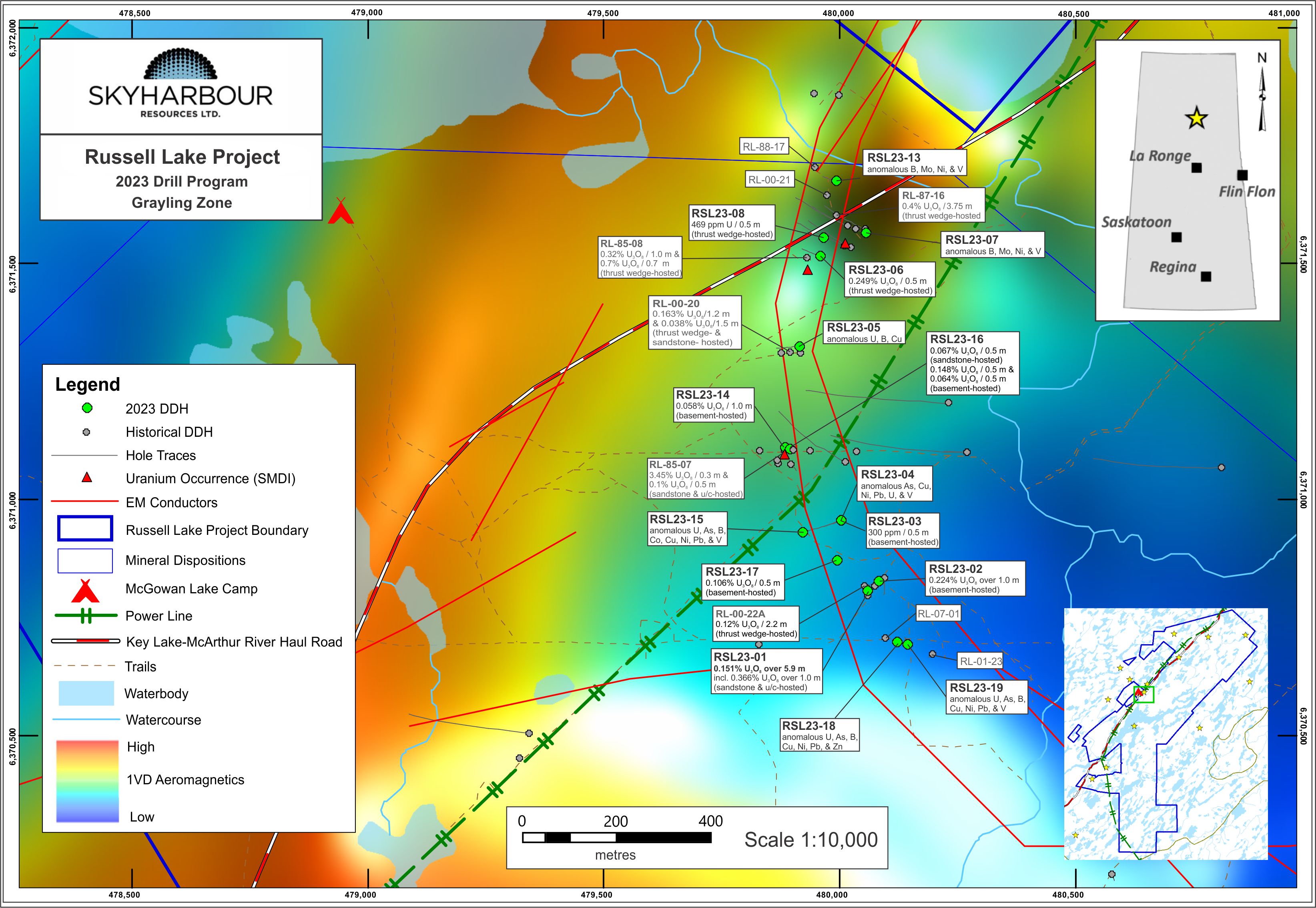
Phase Two – Fox Lake Trail Zone Drilling:
The second phase of drilling was focused in the Fox Lake Trail area at the north end of the project. Four holes were completed for a total of 2,730 metres. The exploratory holes in this area targeted previously drilled fertile conductors and other previously untested but prospective EM and resistivity features.
Fox Lake Trail Target Area Drill Hole Locations:
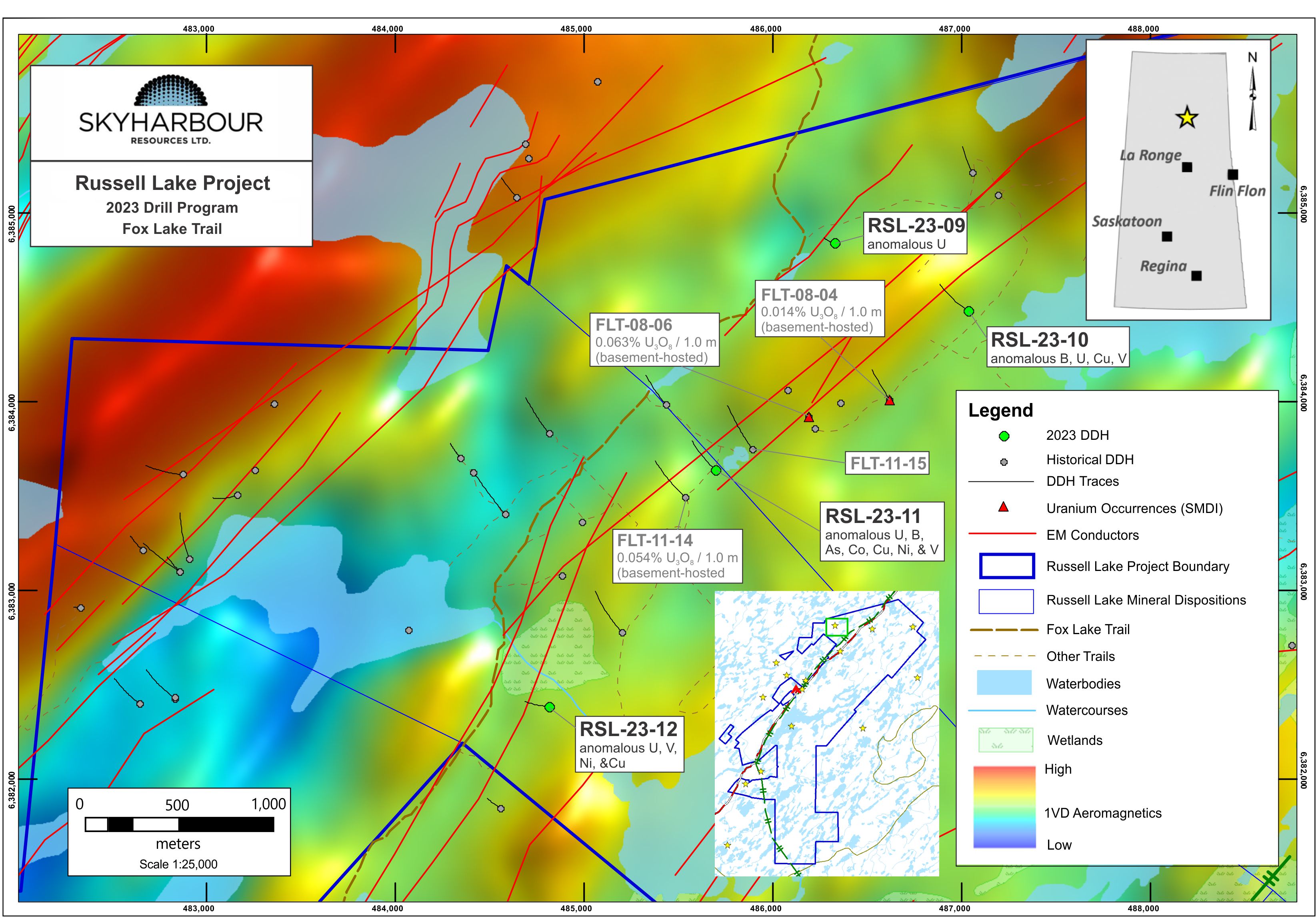
Phase Three – Grayling Zone Drilling:
The third phase and final phase of drilling took place within the Grayling Zone, with seven holes completed for a total of 3,203 metres. This phase of drilling was designed to follow up on previously identified mineralization and to better define the controls and geometry of the Grayling Thrust Block, which is the controlling structure hosting the Grayling mineralized zone.

